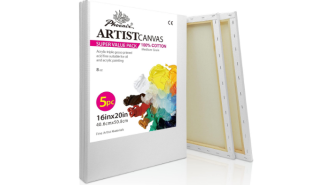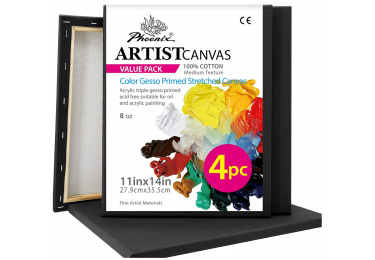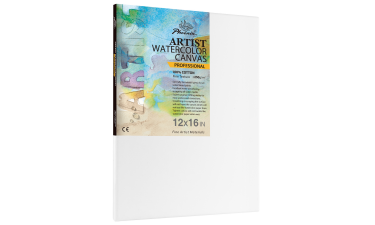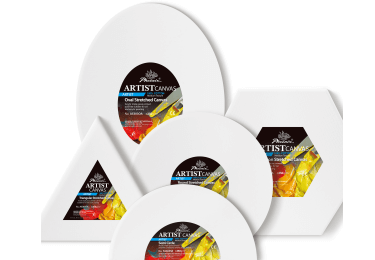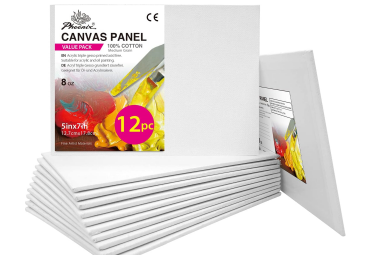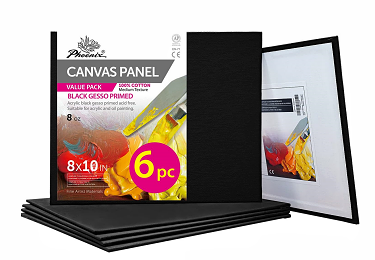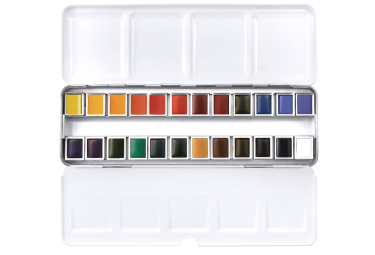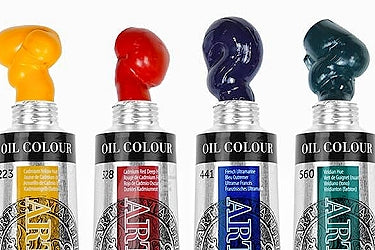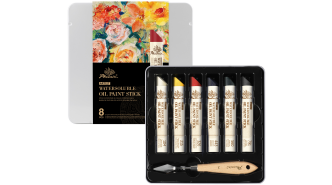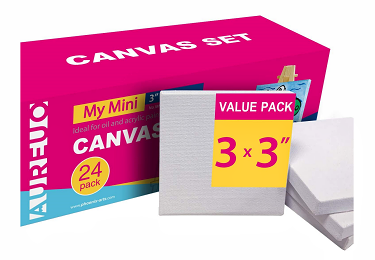Can You Use Stretched Canvas for Watercolor?
If you love watercolor painting, you might be wondering: Can I use a stretched canvas instead of traditional watercolor paper? The answer is yes, but with a few special considerations.
What Is Stretched Canvas?
A stretched canvas for painting is a high-quality fabric—usually cotton or linen—that is tightly stretched over a wooden frame. This type of canvas is widely used in oil painting and acrylic painting because of its durability, texture, and ability to hold thick layers of paint. Compared to paper, a stretched canvas art piece has a professional, gallery-style appearance and does not require framing.
Can You Use Watercolor on a Stretched Canvas?
Yes, you can use watercolors on a stretched canvas, but it requires proper preparation. Unlike watercolor paper, traditional stretched canvas is designed for acrylic and oil paints, meaning it does not absorb watercolors as easily. However, by choosing a stretched watercolor canvas—or treating a regular canvas with a watercolor ground—you can achieve beautiful, fluid watercolor effects while enjoying the benefits of a durable, framed painting surface.
Using a stretched canvas for watercolor painting allows artists to experiment with new textures and styles while creating long-lasting artwork. In the next section, we’ll explore how to choose the best stretched canvas for watercolor painting and what key features to look for.
What to Look for in a Stretched Canvas for Watercolor
Not all stretched canvas art is created equal—especially when it comes to watercolor painting. Choosing the right stretched canvas for watercolor ensures better paint absorption, smoother blending, and a more satisfying painting experience. Here’s what to look for:
1. Material Selection: Cotton vs. Linen vs. Synthetics
Cotton Canvas – Soft, affordable, and commonly used for acrylic and oil painting, but it needs special treatment to work well with watercolors.
Linen Canvas – Stronger and more durable than cotton, with a tighter weave that provides a smooth surface for watercolor techniques.
Synthetic Canvas – Generally not recommended for watercolor, as it lacks the necessary absorbency.
For the best results, choose a stretched watercolor canvas made from cotton or linen, as these materials hold moisture better than synthetic options.
2. Absorbency: Why It Matters & How to Test It
Watercolor requires a porous surface to properly absorb pigments without pooling or beading. To test a canvas:
✔ Lightly wet the surface—if water sits on top or forms droplets, the canvas needs further preparation.
✔ If water absorbs evenly, the canvas is ready for painting.
A stretched canvas for watercolor painting should have a surface that interacts well with water-based paints, allowing for smooth color transitions and layering.
3. Primer Handling: Why Acrylic Gesso Won’t Work
Most stretched canvas art comes pre-primed with acrylic gesso, which repels water rather than absorbing it. To make a stretched canvas suitable for watercolor, apply watercolor ground, a special primer that enhances absorbency and mimics the texture of watercolor paper.
Pro Tip: Apply two to three thin coats of watercolor ground, letting each layer dry completely before painting.
4. Canvas Tension & Frame: Preventing Warping
A poorly stretched canvas can warp or sag when exposed to moisture. To ensure a stretched canvas for watercolor remains stable:
✔ Choose a canvas with tight, even tension across the frame.
✔ Opt for a sturdy wooden frame to prevent twisting or bending over time.
By selecting the right material, ensuring proper absorbency, and preparing the surface correctly, you can confidently use stretched canvas for watercolor painting and achieve stunning results. Up next, we’ll compare stretched canvas vs. canvas panels—which one is better for watercolors?
Stretched Canvas vs. Canvas Panel for Watercolor Painting: Which One Should You Choose?
When deciding between a stretched watercolor canvas and a canvas panel for watercolor, it’s important to consider factors like size, storage, price, and who each option is best suited for. Below, we break down the pros and cons of each to help you make the best choice for your painting style and needs.
Key Differences Between Stretched Canvas and Canvas Panel
|
Feature |
Stretched Watercolor Canvas |
Canvas Panel for Watercolor |
|
Size Options |
Ideal for large-format paintings |
Best for small-scale practice pieces |
|
Storage & Framing |
Ready to hang; doesn’t require framing |
Requires framing or mounting for display |
|
Portability |
Bulkier, harder to transport |
Lightweight and easy to carry |
|
Price |
More expensive |
More affordable, great for beginners |
|
Durability |
More resistant to warping; lasts longer |
Can bend or warp over time if not stored properly |
|
Best For |
Professional artists & long-term artwork |
Students, hobbyists & quick practice pieces |
Which One Is Right for You?
Choose stretched watercolor canvas if you want a gallery-ready piece that can be displayed without framing. It’s perfect for larger paintings and professional artists looking for longevity.
Choose a canvas panel for watercolor if you’re a beginner, student, or artist practicing techniques, or if you need a lightweight option for travel.
Both options have their place in an artist’s toolkit, so consider your goals before choosing the best watercolor painting surface for your next masterpiece! Up next, we’ll share expert tips for painting with watercolors on stretched canvas.
How to Successfully Paint Watercolors on Stretched Canvas
Painting with watercolors on a stretched canvas for watercolor requires different techniques compared to traditional watercolor paper. The key is proper preparation, mastering moisture control, and knowing how to troubleshoot common issues. Below, we’ll cover how to paint watercolor on stretched canvas with practical, easy-to-follow tips.
Step 1: Pre-Preparation for Watercolor on Canvas
Before you start painting, it’s essential to prepare your stretched canvas properly to ensure the best results.
✔Apply a Watercolor Primer (Ground): Most stretched canvases are pre-primed with acrylic gesso, which repels water instead of absorbing it. To fix this, apply two to three layers of watercolor ground and let it dry for at least 24 hours. This creates an absorbent surface for watercolors.
“Phoenix watercolor stretched canvas is primed with watercolor ground, allowing you to paint directly on the watercolor stretched canvas.”
✔Adjust the Canvas for Absorption: If you’re working with a pre-primed canvas, lightly sand the surface before applying the watercolor ground to improve absorption.
✔Test the Surface: Before starting your painting, test a small corner to see how the watercolor behaves. If water beads up, you may need an extra layer of primer.
Step 2: Essential Painting Techniques
✔Control Moisture: Since canvas absorbs water differently than paper, avoid using excess water to prevent paint from pooling or spreading unpredictably. Work in thin, controlled layers.
✔Layer Colors Gradually: Watercolor on stretched canvas tends to lift off more easily than on paper, so allow layers to dry completely before adding another wash.
✔Avoid Uncontrolled Paint Flow: Since stretched canvas is less absorbent than watercolor paper, using a dry brush technique or less diluted paint can help maintain control.
Step 3: Common Problems and How to Fix Them
✔Canvas Warping or Distortion: If the stretched canvas starts to warp after applying watercolor, lightly mist the back of the canvas with water and let it dry naturally to restore its tension.
✔Correcting Color Mistakes: Unlike watercolor paper, stretched canvas allows for easy corrections—simply use a damp brush or sponge to lift off mistakes without damaging the surface.
✔Preserving the Artwork: To keep your watercolor painting vibrant for years, seal the finished piece with a UV-resistant, matte fixative spray to protect it from humidity and dust.
By following these watercolor on canvas tips, you can create stunning artwork on stretched canvas while maintaining the fluid beauty of watercolor painting. Now that you’re equipped with expert techniques, why not explore high-quality stretched watercolor canvases for your next work of art?

